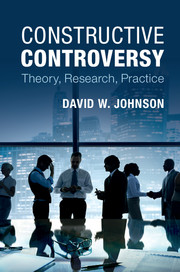Book contents
- Frontmatter
- Contents
- List of figures
- List of tables
- Acknowledgments
- 1 Underlying foundations of constructive controversy
- 2 The nature of constructive controversy
- 3 Theory of constructive controversy
- 4 The processes of constructive controversy and concurrence seeking
- 5 The outcomes of constructive controversy
- 6 Conditions mediating the effects of constructive controversy
- 7 Constructive controversy and decision making
- 8 Constructive controversy in education
- 9 Constructive controversy and political discourse in democracies
- 10 Constructive controversy, creativity, and innovation
- 11 Constructive controversy and building and maintaining peace
- 12 Conclusions
- References
- Index
3 - Theory of constructive controversy
Published online by Cambridge University Press: 05 June 2015
- Frontmatter
- Contents
- List of figures
- List of tables
- Acknowledgments
- 1 Underlying foundations of constructive controversy
- 2 The nature of constructive controversy
- 3 Theory of constructive controversy
- 4 The processes of constructive controversy and concurrence seeking
- 5 The outcomes of constructive controversy
- 6 Conditions mediating the effects of constructive controversy
- 7 Constructive controversy and decision making
- 8 Constructive controversy in education
- 9 Constructive controversy and political discourse in democracies
- 10 Constructive controversy, creativity, and innovation
- 11 Constructive controversy and building and maintaining peace
- 12 Conclusions
- References
- Index
Summary
INTRODUCTION
Humans are unique as a species in being able to decide which evolutionary pathways on Earth will remain open and which will forever be closed. Human intelligence and creativity has given humanity the capacity to change the environment in which they live. This same capacity gives humanity the power to destroy the Earth. The legacy humanity has created is that if we want an animal or a plant to become extinct, we have the power to make it happen. No other creature has ever managed to do this. Even other branches of the human species did not seem to have this power. Neanderthals lived in Europe for over 100,000 years but did not significantly change the Earth's environment. Homo Sapiens, however, after having been on the Earth for only 40,000 years or so, may be creating global warming and the sixth major extinction in the history of the Earth (Kolbert, 2014).
There is a group of scientists who believe that global warming, the mass extinction of plants and animals, and other changes on the Earth have nothing to do with humans and their activities. It is a naturally occurring cycle. Other scientists believe that humans are responsible for the changes in the environment. Either way, regardless of the cause, the changes in the environment endanger the future of humanity. We should probably take action to ensure our long-term survival. It should be noted, however, that some scientists believe environmental change is too far advanced for anything to be done about it, and humanity is doomed and will become extinct regardless of what we now do.
Imagine that you are in charge of structuring a constructive controversy to determine the most appropriate course of action for humanity to take. When the “there is nothing we can do” position is taken off the table (as there is no use talking about it if the situation is hopeless), there are two (or more) alternatives left.
- Type
- Chapter
- Information
- Constructive ControversyTheory, Research, Practice, pp. 29 - 40Publisher: Cambridge University PressPrint publication year: 2015
- 2
- Cited by



